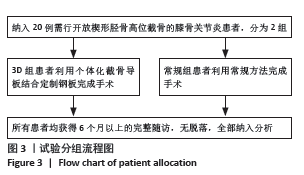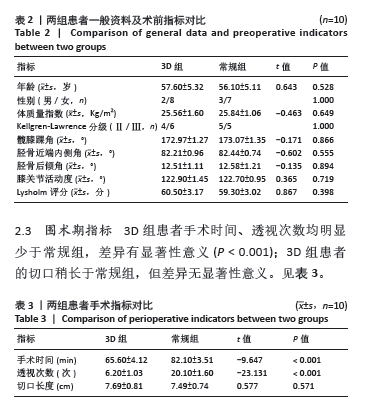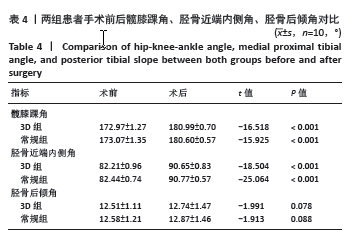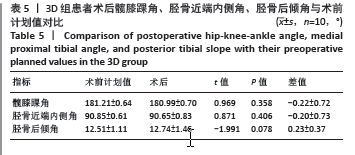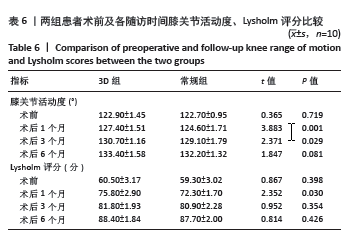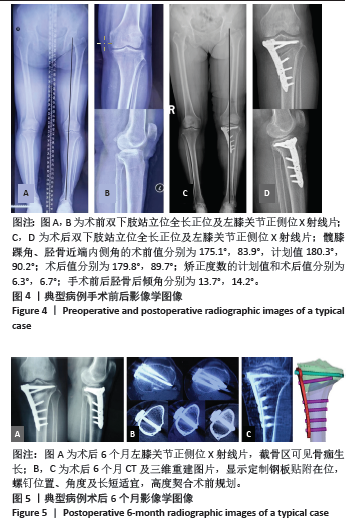1] LI D, LI S, CHEN Q, et al. The Prevalence of Symptomatic Knee Osteoarthritis in Relation to Age, Sex, Area, Region, and Body Mass Index in China: A Systematic Review and Meta-Analysis. Front Med. 2020;7:304.
[2] 中华医学会骨科学分会关节外科学组, 中国医师协会骨科医师分会骨关节炎学组, 湘雅医院国家老年疾病临床医学研究中心, 等. 中国骨关节炎诊疗指南(2021年版)[J]. 中华骨科杂志,2021, 41(18):1291-1314.
[3] 黄野. 胫骨高位截骨术治疗膝关节骨关节炎的现状[J]. 中华关节外科杂志(电子版),2016,10(5):470-473.
[4] VAN DEN BEMPT M, VAN GENECHTEN W, CLAES T, et al. How accurately does high tibial osteotomy correct the mechanical axis of an arthritic varus knee? A systematic review. Knee. 2016;23(6):925-935.
[5] ABDULLAH KA, REED W. 3D printing in medical imaging and healthcare services. J Med Radiat Sci. 2018;65(3):237-239.
[6] MARRO A, BANDUKWALA T, MAK W. Three-Dimensional Printing and Medical Imaging: A Review of the Methods and Applications. Curr Probl Diagn Radiol. 2016;45(1):2-9.
[7] VAN GENECHTEN W, VAN TILBORG W, VAN DEN BEMPT M, et al. Feasibility and 3D Planning of a Novel Patient-Specific Instrumentation Technique in Medial Opening-Wedge High Tibial Osteotomy. J Knee Surg. 2021;34(14):1560-1569.
[8] MIAO Z, LI S, LUO D, et al. The validity and accuracy of 3D-printed patient-specific instruments for high tibial osteotomy: a cadaveric study. J Orthop Surg Res. 2022;17(1):62.
[9] 马驰, 朴成哲. 3D打印个体化截骨导板辅助开放楔形胫骨高位截骨术的应用现状[J]. 中国修复重建外科杂志,2023,37(3):360-364.
[10] 潘建科, 赵第, 金晓, 等. 内侧开放楔形胫骨高位截骨与植入物相关的失误和并发症分析[J]. 中国组织工程研究,2022,26(36): 5849-5856.
[11] 侯森荣, 潘建科, 杨伟毅, 等. 胫骨高位截骨术前临床评估及适应证的选择策略[J]. 中国组织工程研究,2019,23(28):4576-4583.
[12] KELLGREN JH, LAWRENCE JS. Radiological assessment of osteoarthrosis. Ann Rheum Dis. 1957;16(4):494-502.
[13] LIU GB, LIU S, ZHU CH, et al. A novel 3D-printed patient-specific instrument based on “H-point” for medial opening wedge high tibial osteotomy: a cadaver study. J Orthop Surg Res, 2022,17(1):169.
[14] 钟达, 齐军. 骨关节炎阶梯化治疗,方兴未艾![J]. 中国现代医学杂志,2021,31(23):1-5.
[15] CERCIELLO S, OLLIVIER M, CORONA K, et al. CAS and PSI increase coronal alignment accuracy and reduce outliers when compared to traditional technique of medial open wedge high tibial osteotomy: a meta-analysis. Knee Surg Sports Traumatol Arthrosc. 2022,30(2): 555-566.
[16] 仲鹤鹤, 金瑛, 刘修齐, 等. 胫骨高位截骨联合关节镜手术治疗膝内翻骨关节炎的近期疗效及二次关节镜探查结果[J]. 中国修复重建外科杂志,2022,36(8):969-975.
[17] CHERNCHUJIT B, THARAKULPHAN S, PRASETIA R, et al. Preoperative planning of medial opening wedge high tibial osteotomy using 3D computer-aided design weight-bearing simulated guidance: Technique and preliminary result. J Orthop Surg (Hong Kong). 2019; 27(1):615491743.
[18] 李小兵, 郭新军, 冯立平, 等. 3D打印辅助高位胫骨截骨治疗内侧室膝骨关节炎[J]. 中国矫形外科杂志,2021,29(21):1950-1954.
[19] PREDESCU V, GROSU AM, GHERMAN I, et al. Early experience using patient-specific instrumentation in opening wedge high tibial osteotomy. Int Orthop. 2021;45(6):1509-1515.
[20] MACLEOD AR, MANDALIA VI, MATHEWS JA, et al. Personalised 3D Printed high tibial osteotomy achieves a high level of accuracy: ‘IDEAL’ preclinical stage evaluation of a novel patient specific system. Med Eng Phys. 2022;108:103875.
[21] ZAFFAGNINI S, DAL FABBRO G, LUCIDI GA, et al. Personalised opening wedge high tibial osteotomy with patient-specific plates and instrumentation accurately controls coronal correction and posterior slope: Results from a prospective first case series. Knee. 2023;44:89-99.
[22] YANG JC, CHEN CF, LUO CA, et al. Clinical Experience Using a 3D-Printed Patient-Specific Instrument for Medial Opening Wedge High Tibial Osteotomy. Biomed Res Int. 2018;2018:9246529.
[23] VICTOR J, PREMANATHAN A. Virtual 3D planning and patient specific surgical guides for osteotomies around the knee: a feasibility and proof-of-concept study. Bone Joint J. 2013;95-B(11 Suppl A):153-158.
[24] JONES GG, JAERE M, CLARKE S, et al. 3D printing and high tibial osteotomy. EFORT Open Reviews. 2018;3(5):254-259.
[25] JÖRGENS M, KEPPLER AM, AHRENS P, et al. 3D osteotomies—improved accuracy with patient-specific instruments (PSI). Eur J Trauma Emerg Surg. 2024;50(1):3-10.
[26] SAVOV P, HOLD M, PETRI M, et al. CT based PSI blocks for osteotomies around the knee provide accurate results when intraoperative imaging is used. J Exp Orthop. 2021;8(1):47.
[27] GAO F, YANG X, WANG C, et al. Comparison of Clinical and Radiological Outcomes between Calibratable Patient-Specific Instrumentation and Conventional Operation for Medial Open-Wedge High Tibial Osteotomy: A Randomized Controlled Trial. Biomed Res Int. 2022; 2022:1378042.
[28] FUCENTESE SF, MEIER P, JUD L, et al. Accuracy of 3D-planned patient specific instrumentation in high tibial open wedge valgisation osteotomy. J Exp Orthop. 2020;7(1):7.
[29] 朱超华, 李佳, 刘国彬, 等. 成人胫骨平台后内侧“H”点的应用解剖学研究[J]. 实用骨科杂志,2022,28(3):220-222.
[30] KIM HJ, PARK J, SHIN JY, et al. More accurate correction can be obtained using a three-dimensional printed model in open-wedge high tibial osteotomy. Knee Surg Sports Traumatol Arthrosc. 2018;26(11): 3452-3458.
[31] ZHU X, QIAN Y, LIU A, et al. Comparative outcomes of patient-specific instrumentation, the conventional method and navigation assistance in open-wedge high tibial osteotomy: A prospective comparative study with a two-year follow up. Knee. 2022;39:18-28.
[32] MICICOI G, CORIN B, ARGENSON JN, et al. Patient specific instrumentation allow precise derotational correction of femoral and tibial torsional deformities. Knee. 2022;38:153-163. |
